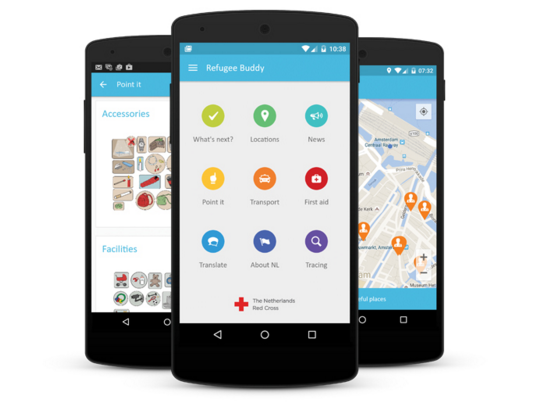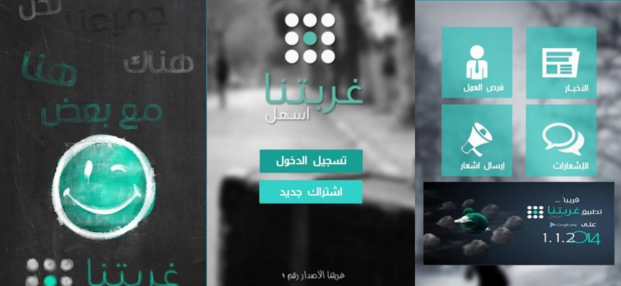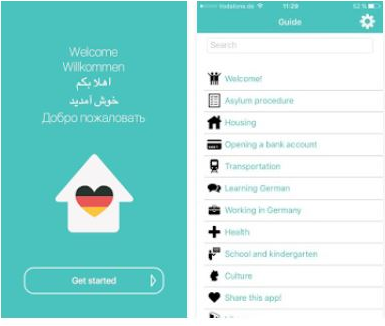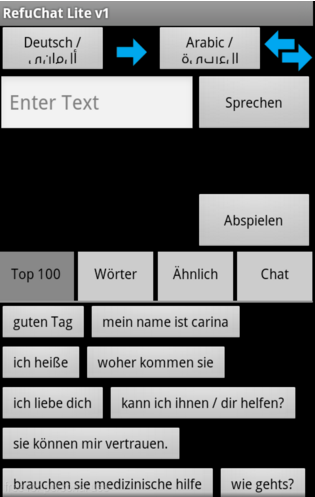
Asylum Seeker Apps
Which apps do the asylum seekers use and why? What insights can their developers share with us?
Apps and social media not only play a part in the process of migration but also play a crucial role when asylum seekers are trying to settle down again. Once asylum seekers have found a place where they, for the time being at least, are allowed to stay, apps and social media play a big part in their lives.
As seen in Hasan’s story, smartphones are used for communication as well as for obtaining information. Communication and information are not only relevant in the process of migration but also in settling down. Keeping others up to date on one’ s whereabouts and well-being is as important as gathering information. This will aid in the adjustment of oneself to the new surroundings.
For this reason, there are a lot of available apps that target asylum seekers and refugees specifically. In order to get an idea of these apps we will now take a closer look at some of them and their functions.
Refugee Buddy

Refugee Buddy App
'Refugee Buddy' is an app provided by the Dutch Red Cross. The app aims to provide up to date and relevant information to refugees and asylum seekers in the Netherlands. The app is available in four languages: English, Arabic, French and Tigrinya. The app answers the basic needs of someone who has just arrived in the Netherlands, for example the app may help to:
- find your way in the Netherlands
- translate or point out your needs
- get information about the procedure for asylum seekers
- stay informed o about the latest news
- know what to do in case of an accident
This app is mainly directed at asylum seekers who have arrived in the Netherlands. We have talked to Roek Lips, the initiator of this app and his story can be read below .
Gherbtna

Gherbtna App
'Gherbtna' in Arabic means loneliness, exile. This concept is the one that many refugees can relate to. 'Gherbtna' is also the name of an app designed for Syrians who are trying to build a new life in Turkey. This app is used to inform the asylum seekers as well. In the app, there are available job positions, news and information on studying in Turkey.
This app seems to go a step further than the 'Refugee Buddy' app which only provided some basic information on life in the Netherlands. Gherbtna actually goes further in the process of helping refugees settle down in Turkey. The app was designed by Mojahed Akil, a 25yearold who himself migrated to Turkey in 2013. We had an opportunity to ask him some questions about the app, which can be read below in the article.
Refugermany

Refugermany App
'Refugermany' is another app that aims to inform asylum seekers about their new environment. As the name already suggests, the app is directed to asylum seekers in Germany. The app provides information on asylum procedures, transportation, working in Germany and so on. Below in the article you can read about the motivation behind this app, as we got some inside information from one of the makers of the app.
Refuchat

Refuchat App
'Refuchat' is another German app. What makes this app interesting is that it’s not mainly directed to the asylum seekers themselves but towards helpers and paramedics that work with refugees but don’t speak their language. Even though the app isn’t actually meant to be used by asylum seekers, it is still relevant for this article; the app might not be designed to be used by asylum seekers, but it is definitely designed to help them.
Refugee Phrasebook
'Refugee Phrasebook' is more than just an app, as the video above explains: ‘it’s an open collection of useful words and phrases for refugees and helpers’. This collection is distributed in many different ways (print, website, app, etc.) so that as many people as possible have access to it. Naturally, the aim of this app is to make communication between people of different backgrounds possible or easier.
In the apps discussed above, we can see that the ones designed for refugees mainly focus on providing them with information. As we have seen in Hasan’ s story, the apps for communication (such as 'Viber' and 'Skype') are already in use so there is not much need for communication apps as there is for informative apps. Of course, there also apps that focus on communication ('Refuchat', 'Refugee Phrasebook') but not in the sense that is first thought of in this context. The apps for communication aim at bridging language gaps that exist between two groups:asylum seekers and inhabitants of the country they have ended up in.
App makers
When it comes to apps, we should not only consider the people using the apps but also the people who are behind the making of these apps ('Refugee Buddy', 'Gherbtna' and 'Refugermany'). What has inspired them to make these apps and how have they actually started working on them? We have spoken to the people behind some of the apps and asked them what their process was like.
First of all, we got to speak to Roek Lips who took the initiative for the 'Refugee Buddy' app. ‘The idea (for the app, red.) came to be because of a picture we saw in the newspaper last summer of a boy, a refugee, who was taking a picture of himself, a selfie, on the beach in Greece’, Roek explains. Thanks to this picture, the question of how the refugees would be able to use their phones arose and that was how the idea for the 'Refugee Buddy' appeared.
Lips conveyed his idea to the Red Cross and they thought it would be an interesting idea. From there, it was picked up and an app builder was involved for the technical aspect of the project. There were also people involved who, together with Lips, took up the editorial job. Of course, there were also people involved in the stage of distribution. The Red Cross initially invested their money, but they involved other parties as well. The whole process went fast; the idea came up at the end of September 2015 and the first version was done in December 2015.
What started with a picture in a newspaper now is one of the main information facilities for asylum seekers in the Netherlands. Lips explains: ‘we also work together with (the ministry of, red.) Security and Justice and IND and COA, the GCD, the Aliens Police, Vluchtelingenwerk, well you name it’. These are all starring members who are affiliated with accompanying refugees. Lips meets with the representatives of these groups regularlyand they also spread their information via the app. Klaas Dijkhoff, the Undersecretary for Security and Justice, knows how to find Lips when he has information to share via the app.
Initially, the app primarily focused on the refugees who had just arrived in the Netherlands. If you know nothing and youare not in the process of getting a residence permit yet, you don’t get any information from COA. Lips explains that they thinkthat ‘information nowadays is also a form of emergency aid’. Refugees themselves were involved in the development of the content and they still are.
'Information nowadays is also a form of emergency aid’ - Roek Lips, maker of the Refugee Buddy app
The project group is already focusing on the future. Lips says: ‘We’ re also already talking about a second version and we’ re actually thinking about a third version that focuses on integration for when people have a residence permit. So we’ re expending it inthat way’.
As above mentioned, the app 'Gherbtna' is developed by Mojahed Akil, a 25-year-old who himself migrated to Turkey in 2013. The main reason for him to have created this app ‘is to help Syrian refugees to get a better and easier life by providing them with information’. He came up with the idea when he moved to Turkey and faced a lot of difficulties while living there. He received a lot of feedback, but ‘the main one is the app is very useful and helpful’. Akil explains that the project isn’t funded by external parties. Yet, there is an advertising section on the website and the Facebook page so that is how the app is funded, as a matter of fact.
We also received some inside information from Marius Luther from 'Refugermany'. He explains that ‘it's essentially a digital version of a welcome guide that volunteers have been printing and handing out to refugees in Berlin before and we thought it could help to have an app that can easily be updated and doesn't cost additional money for each printed copy’. In the making of this app, refugees were also involved in deciding what sort of content the app would have
It is evident that the main reason for these app makers to have made their apps is, in fact,to help the refugees. The app designers saw that asylum seekers were using their phones and that they needed information so they linked these two facts and provided them information through apps. The content of the apps is mostly depended on the needs of the asylum seekers, who were also involved in the making of the apps. Thanks to these useful apps, the new way of spreading information among asylum seekers is facilitated.